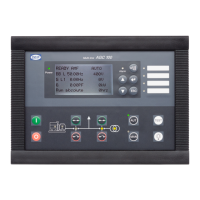The integrating function of the I regulator is increased if the integral action time is decreased. This means that
a lower setting of the integral action time Ti results in a faster regulation.
If the Ti is adjusted to 0 s, the I regulator is switched OFF.
The integral action time Ti must not be too low. This will make the regulation hunt, similar to a
too high proportional action factor Kp.
Differential regulator
The main purpose of the differential regulator (D regulator) is to stabilise the regulation, thus making it possi-
ble to set a higher gain and a lower integral action time Ti. This will make the overall regulation eliminate devi-
ations much faster.
In most cases, the differential regulator is not needed; however, in case of very precise regulation situations,
for example static synchronisation, it can be very useful.
The output from the D regulator can be explained with the equation:
D = Regulator output
Kp = Gain
de/dt = Slope of the deviation (how fast the deviation occurs)
This means that the D regulator output depends on the slope of the deviation, the Kp and the Td setting.
Example: In the following example, it is assumed that Kp = 1.
D-regulator
0
1
2
3
4
5
6
7
8
0 0.5 1 1.5 2 2.5
Time [s]
Output/deviation
Deviation 2
D-output 2, Td=1s
Deviation 1
D-output 2, Td=0.5 s
D-output 1, Td=0.5 s
AGC 100 Designer's Reference Handbook
4189340766 UK
PID controller (AGC 110 only)
DEIF A/S Page 144 of 152

